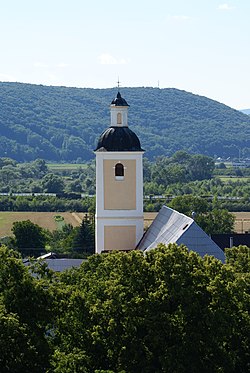Beckov
Village in Slovakia From Wikipedia, the free encyclopedia
Village in Slovakia From Wikipedia, the free encyclopedia
Seamless Wikipedia browsing. On steroids.
Every time you click a link to Wikipedia, Wiktionary or Wikiquote in your browser's search results, it will show the modern Wikiwand interface.
Wikiwand extension is a five stars, simple, with minimum permission required to keep your browsing private, safe and transparent.
Beckov (Hungarian: Beckó, German: Beckow) is a village and municipality in the Nové Mesto nad Váhom District in the Trenčín Region of western Slovakia.
Beckov | |
|---|---|
Village | |
 Church | |
Location of Beckov in the Trenčín Region | |
| Coordinates: 48°47′N 17°54′E | |
| Country | |
| Region | Trenčín |
| District | Nové Mesto nad Váhom |
| First mentioned | 1208 |
| Area | |
| • Total | 28.62[1] km2 (11.05[1] sq mi) |
| Elevation | 190[2] m (620[2] ft) |
| Population (2021) | |
| • Total | 1,445[3] |
| Postal code | 916 38[2] |
| Area code | +421 32[2] |
| Car plate | NM |
| Website | www.obec |
In historical records the village was first mentioned in 1208. Mihály de genere Bána, royal equerry, who was the forefather of the Cseszneky family, performed several heroic deeds against the Mongolian invaders of Hungary (during the invasion in 1241–42) and for his bravery in 1241 King Béla IV appointed him Count (comes) of Beckó. Before the establishment of independent Czechoslovakia in 1918, Beckov was part of Trencsén County within the Kingdom of Hungary. From 1939 to 1945, it was part of the Slovak Republic. On the 6th of April 1945, the Red Army dislodged the Wehrmacht from Beckov and it was once again part of Czechoslovakia.
The municipality lies at an altitude of 190 metres and covers an area of 28.629 km2. It has a population of about 1375 people.[year needed]
Overlooking the village is Beckov Castle, now in ruins. The village, which used to be a town, was fortified by a mighty wall, large parts of which are still preserved. Religious buildings include the gothic catholic parish church and the former baroque Franciscan monastery with a church located within the walled town and a protestant parish church found outside the walls. There are several Renaissance and Baroque manors, some of which are restored and well-kept while others are dilapidated and falling into ruins.
The records for genealogical research are available at the state archive in Bratislava (Slovak: Štátny archív v Bratislave).